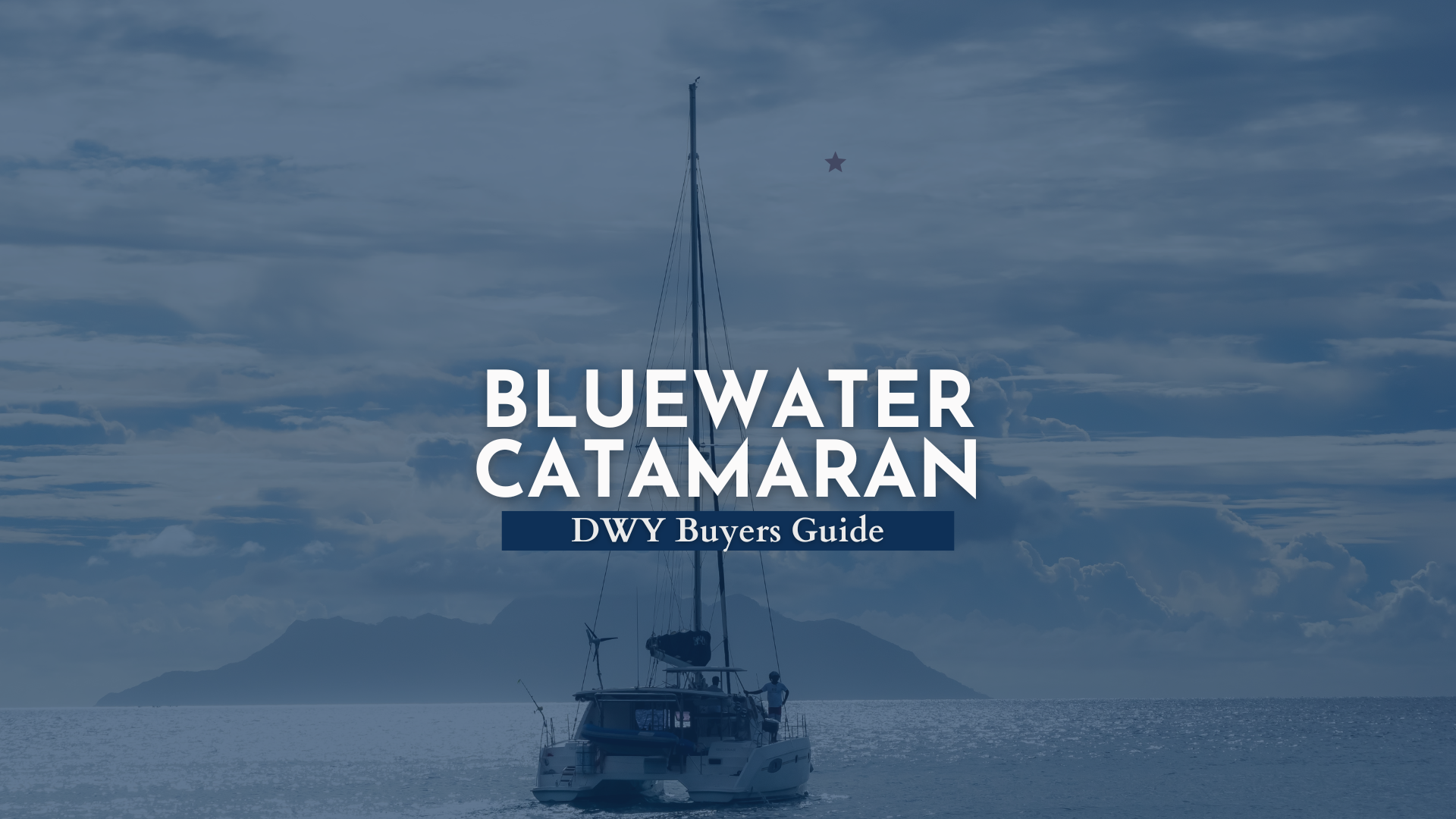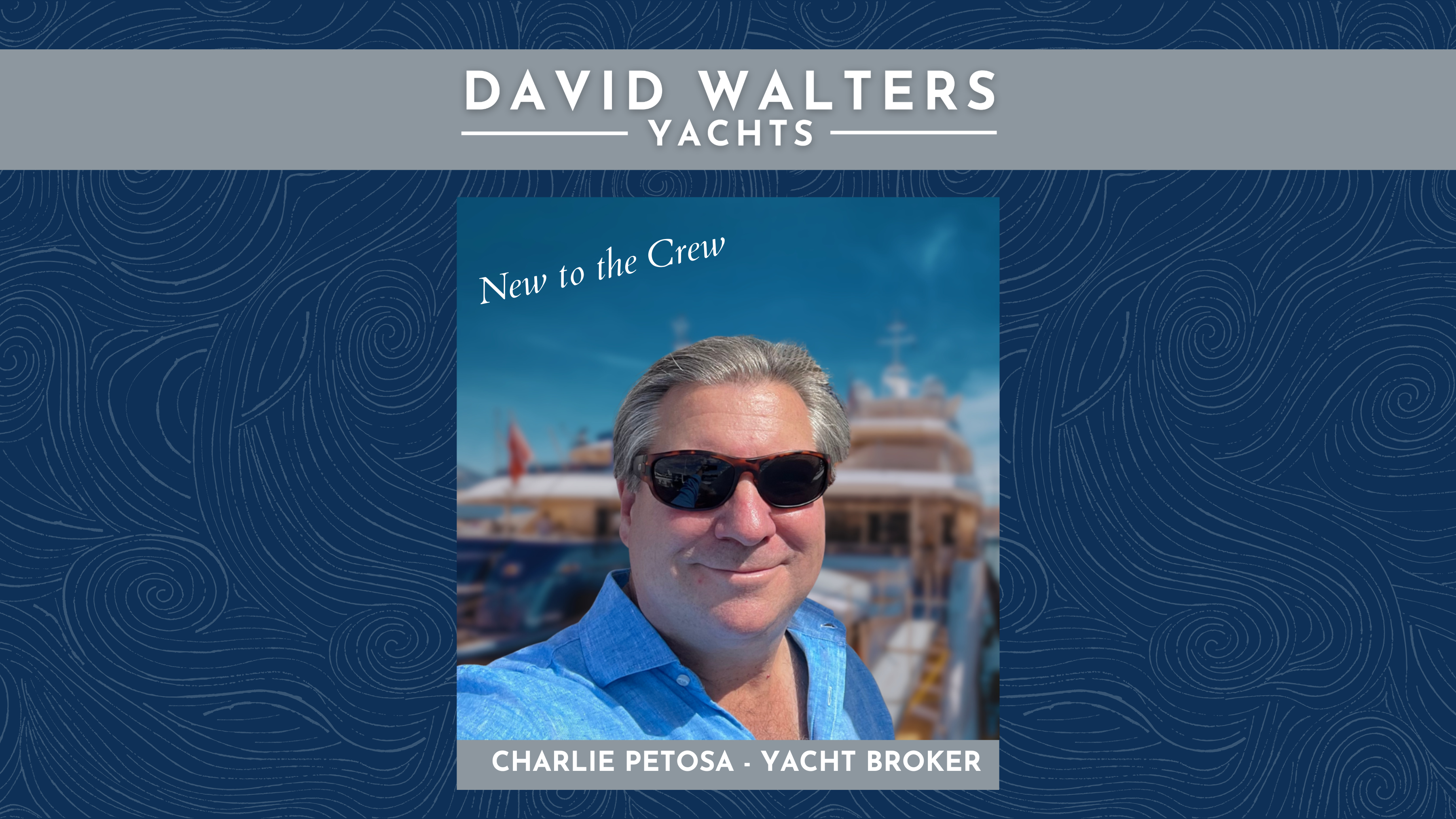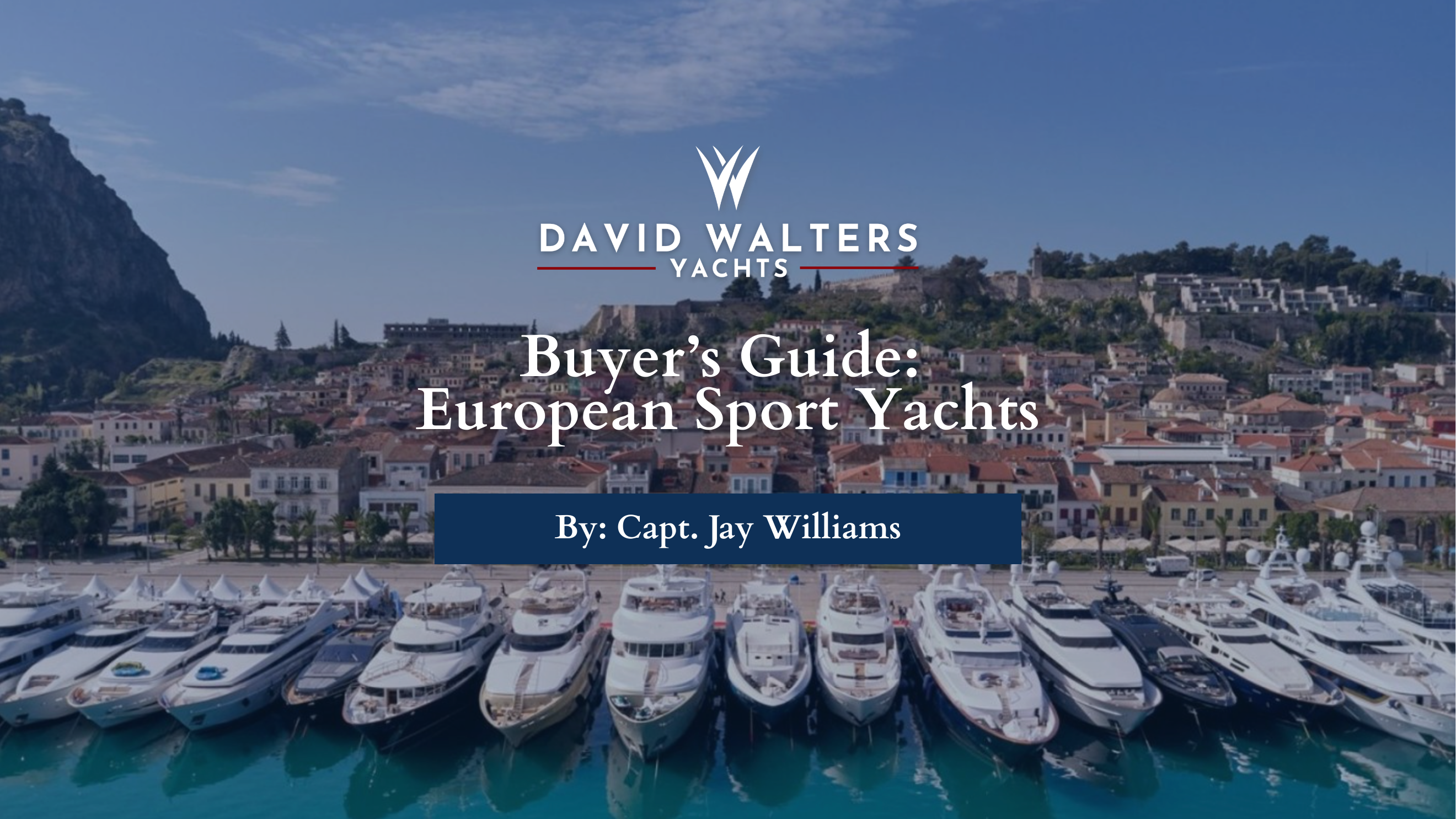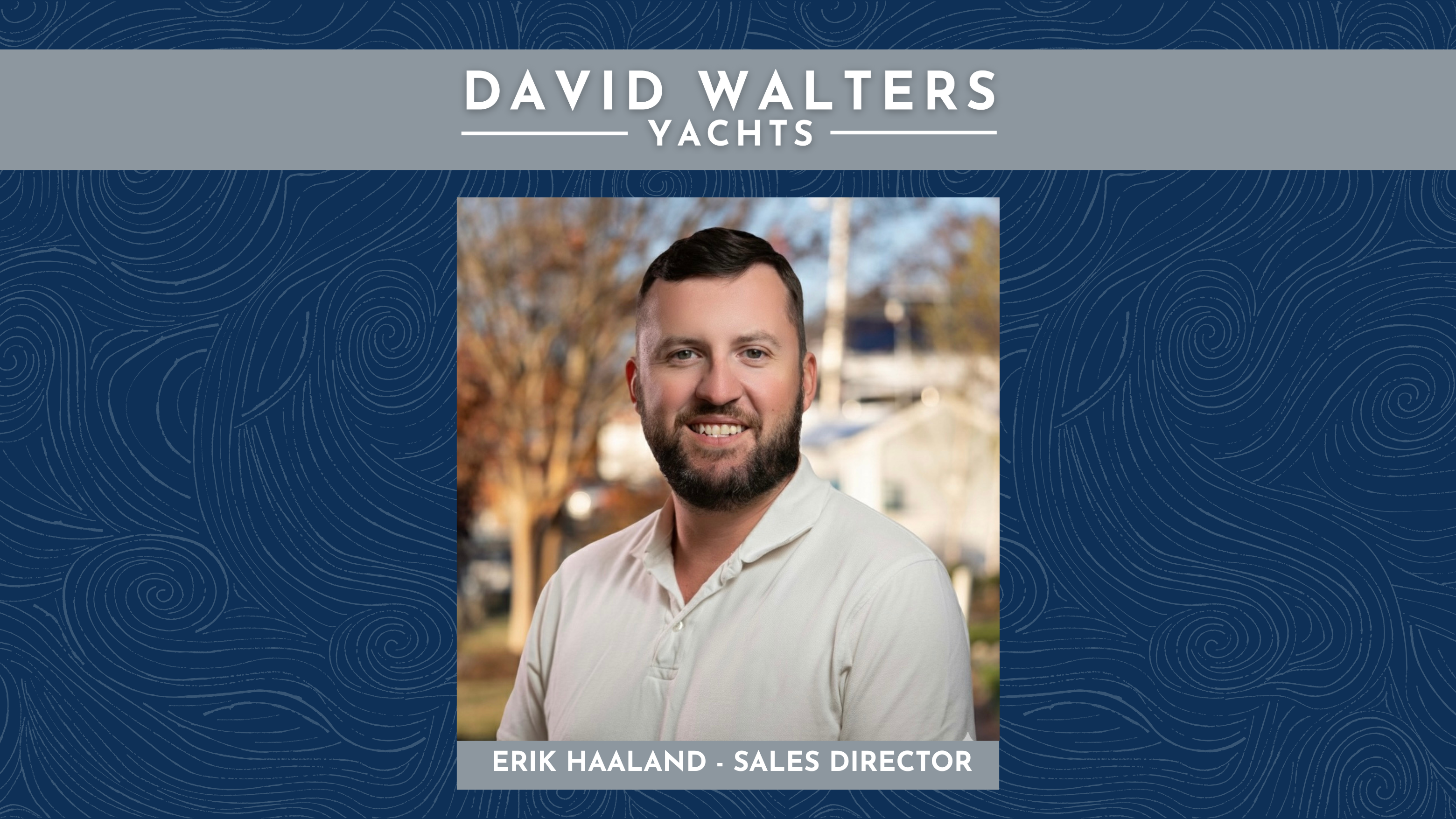DWY Guide to Choosing the Perfect Bluewater Catamaran
In This Guide:
The DWY Bluewater Catamaran Buyer’s Guide is designed to help sailors make confident, informed decisions when choosing a catamaran for offshore cruising. Inside, you’ll find a deep dive into the advantages and trade-offs of multihull design, a framework for evaluating models, answers to common buyer questions, and a detailed marine survey and sea-trial checklist. Whether you’re planning island-hopping adventures or ocean passages, this guide gives you the tools to match the right yacht to your cruising goals.
The DWY Guide to Buying a Bluewater Catamaran
- Why Bluewater Sailors Choose Catamarans
- The DWY Decision Framework
- Structure & Safety Essentials
- Performance & Seakeeping
- Propulsion & Drivetrains
- Energy, Water, and Electronics for Independence
- Brand & Model Landscape
- New vs. Brokerage Purchase
- Inspection & Seatrial Checklist
- How DWY Structures a Successful Purchase
Why Bluewater Sailors Choose Catamarans
(and when they shouldn’t)
It’s no surprise that more and more bluewater sailors are turning to catamarans. The appeal is clear: sailing level is easier on the body, the living spaces are spacious and connected, and the shallow draft means you can explore places that many monohulls can’t get near. Families love the safety and comfort, while couples appreciate how easy life aboard feels compared to a boat that’s constantly heeled over. Add in the peace of mind of two engines, two rudders, and generally more redundancy built into the systems, and it’s easy to see why multihulls are in such high demand.

But they’re not the right answer for everyone. Catamarans demand discipline with loading—too much gear and provisions can turn a lively boat into a sluggish one that slams uncomfortably in a seaway. Some models, especially those with low bridge-deck clearance, are prone to pounding in head seas. And the flybridge layouts that look so appealing in a marina can add windage and weight aloft that’s less than ideal offshore.
Josh's Advice:
The real key is matching the right design to the kind of sailing you want to do. For many, a catamaran unlocks freedom, safety, and comfort. For others—especially those planning to sail light, long, and hard into heavy weather—a capable monohull might still be the better fit.
Core Advantages
-
Low heel and big volume
Catamarans sail flat. That means cooking, sleeping, and simply moving around the boat are far less tiring. The generous beam provides ample room for a proper salon, spacious cabins, and a cockpit that seamlessly blends into the living space. -
Shallow draft
With many cruising cats drawing less than four feet, whole cruising grounds—the Bahamas, Belize, and French Polynesia—suddenly become available. You can anchor closer to shore and slip into lagoons and passes that monohulls must avoid. -
Redundancy
Two engines don’t just make docking easy; they give you a fallback offshore. Dual rudders and duplicated systems in each hull mean a failure is less likely to end the voyage. -
Passagemaking speed
A well-sailed, lightly loaded cat can routinely knock off 180–200 miles a day. For bluewater sailors, that means shorter weather windows, more options for landfall, and less time at sea.
Key Caveats
-
Weight sensitivity
Unlike many monohulls, cats don’t tolerate excess gear well. Overload them and you’ll feel it quickly—slower speeds, more slamming, and a less comfortable ride. -
Bridge-deck clearance
The space between the underside of the salon floor and the sea matters. Too little clearance and the boat will slam in head seas. Larger designs with more height handle this better. -
Windage and weight aloft
Flybridge cats are incredibly comfortable at anchor, but offshore, the extra windage and higher center of gravity can make handling more challenging and increase fuel consumption. -
Boards vs. keels
Daggerboards enhance performance and enable a shoal draft when raised, but they add complexity. Mini-keels keep things forgiving and straightforward, at the expense of upwind ability.
The DWY Decision Framework
When you’re evaluating whether a catamaran is right for you, it’s not just about the number of cabins or how the galley is laid out. The big picture is what matters: where you plan to sail, who will be aboard, and what trade-offs make sense for your style of cruising. Over the years, we’ve developed a framework that helps our clients cut through the noise and focus on what really counts.

Voyage Profile
Start with where you’re going. Are you planning to island-hop in the Caribbean, or are you dreaming of a Pacific crossing? A couple exploring the Bahamas may prioritize shallow draft and ease of handling, while a family headed across the Atlantic needs a design with more bridge-deck clearance, greater load-carrying ability, and safe watchkeeping from a protected helm. Think through crew size, your comfort level with sail handling, and how often you’ll be moving the boat versus staying put at anchor.
Safety Envelope
Catamarans inspire confidence when they’re well built and properly equipped, but not all designs are created equal. Look beyond the marketing and consider the structure: watertight bulkheads, strong chainplate attachments, secure traveler tracks, and forebeam construction. Escape hatches should be practical and functional, not just there to check a box. These are the details that separate an ocean-ready vessel from a coastal cruiser dressed up to look the part.
Performance and Seakeeping
The right boat should balance speed, comfort, and reliability. Bridge-deck clearance is key—more space under the salon floor means less pounding in a seaway. Sail plan matters too: square-top mains and self-tacking jibs simplify life, while a Code Zero or reaching sail can turn a frustrating light-air passage into an enjoyable run. Daggerboards versus mini-keels is another big decision, and it comes down to whether you value simplicity or performance.
Josh's Advice:
Ultimately, the decision framework is about aligning the boat with your mission. By being honest about your routes, your crew, and your priorities, you’ll end up with a yacht that feels right—not just at the dock, but a thousand miles offshore.
Structure & Safety Essentials
When it comes to evaluating a bluewater catamaran, the conversation always starts with structure. Layouts, finishes, and gadgets can be changed; the bones of the boat cannot. A strong, properly engineered hull and deck give you peace of mind when the weather turns, and they directly affect how comfortable and quiet the boat feels at sea.

The resin and core schedule matters. Look for solid laminate in high-load or slamming areas, with foam or balsa coring used in non-critical zones to save weight and add stiffness. Bulkheads should be fully bonded to both hull and deck, not just tabbed to furniture. This creates a rigid, integrated structure that holds up when the boat is working hard offshore.
Pay close attention to the forward beam and traveler track. These carry enormous loads when the rig is powered up, and any signs of flexing, cracking, or patchwork repairs are red flags. The rudders and steering gear also deserve a thorough inspection: check for play in the bearings, corrosion on the stocks, and make sure there’s a functional emergency tiller system.
Deck hardware should inspire confidence. Stanchions should be through-bolted and well-backed, handholds should be plentiful and well-placed, and reefing lines should be easy to manage from the safety of the cockpit. And don’t overlook watertight integrity—collision bulkheads forward and properly installed escape hatches are critical in the unlikely event of a hull breach.
When a catamaran is well built, it feels different. There’s less creaking underway, less vibration, and more confidence in pushing the boat hard when you need to. That’s the foundation everything else rests on.
Performance & Seakeeping
One of the great appeals of catamarans is their ability to cover serious miles in comfort, but not every design performs the same way at sea. Understanding what really drives performance and how it impacts life aboard helps buyers separate the capable passagemakers from the marina queens.

The first factor is bridge-deck clearance. This is the space between the underside of the salon floor and the waterline. When clearance is too low, the boat will slam loudly in head seas. That constant pounding is tiring for crew and hard on the structure. Higher clearance, combined with sensible loading, makes a world of difference in offshore comfort.
Daggerboards versus mini-keels is another major point. Daggerboards give a real edge upwind and in light air, allowing you to point higher and sail faster averages. They also reduce draft when raised, making it possible to sneak into shallow anchorages. The trade-off is complexity—more moving parts and more maintenance. Mini-keels keep things simple. They’re forgiving, let you safely beach the boat if needed, and require less attention, but at the expense of sailing angles and light-air speed.
Sail plan and rig design matter too. Square-top mains provide more power, but make sure the hardware and track cars are up to the task. A self-tacking jib can make shorthanded sailing a breeze, while a furling Code Zero or reaching sail transforms performance in light winds. Without these options, many owners end up motoring more than they’d like.
At sea, a well-designed catamaran feels light, responsive, and predictable. It makes steady miles without drama, keeps the crew comfortable, and inspires confidence when conditions build. That balance between performance and seakeeping is what separates a true bluewater cat from a coastal cruiser.
Josh's Advice:
Don’t be swayed by speed alone. Real-world performance is about bridge-deck clearance, hull efficiency, and proper loading. The fastest design on paper can still disappoint offshore if overloaded.
Propulsion & Drivetrains
Engines may not be the first thing that comes to mind when dreaming of ocean passages, but they are central to how you’ll actually use the boat. From maneuvering into tight harbors to keeping batteries charged on a cloudy week at anchor, reliable propulsion is essential.

Most catamarans are equipped with saildrives. They’re compact, smooth, and efficient, but they do require discipline when it comes to maintenance. The rubber diaphragm seals should be replaced on schedule, and galvanic protection needs to be watched closely. With proper care, they’re dependable, but ignoring service intervals can create big headaches.
Traditional shaft drives are less common today but remain a solid choice. They take up more space and need alignment checks, but they’re nearly bulletproof in the long run and often easier to service in remote places. For bluewater sailors planning to keep their boat for decades, shafts can be the safer bet.
Propellers also play a key role. Folding or feathering props reduce drag under sail and noticeably improve performance, while fixed props are simple and inexpensive but slow the boat when sailing. Matching the right prop pitch to your engines is critical—too much or too little, and you’ll either overload the motor or miss out on efficiency.
Fuel systems should be set up with redundancy in mind. Dual Racor filters with vacuum gauges make it easy to monitor clogging, and tanks should have inspection ports for cleaning. On a long passage, dirty fuel can shut you down faster than almost anything else, so prevention is everything.
When done right, propulsion on a catamaran fades into the background—you have the confidence that it will be there when you need it, without being a constant source of stress.
Josh's Advice:
Balance simplicity with redundancy. Shaft drives and fixed props are rugged, while saildrives and folding props boost efficiency. Match your drivetrain to the waters you’ll cruise and the maintenance support you can expect.
Energy, Water & Electronics for Independence
One of the biggest shifts when moving from coastal cruising to bluewater voyaging is how self-sufficient you need to become. Catamarans, with their abundant deck and roof space, are particularly well-suited to carry the systems that make long-term independence possible.
Energy starts with the battery bank. Lithium batteries are becoming the standard because of their efficiency, lighter weight, and usable capacity. A properly designed system should give you a full day or two at anchor without running a generator. Solar is the backbone—most cruising cats today carry 1–2 kilowatts of panels, enough to handle refrigeration, lighting, and most daily loads. High-output alternators on the engines and a good inverter/charger round out the system, with a generator often reserved just for air conditioning or heavy loads.
Watermakers are another game-changer. For a couple, a 15–20 gallon-per-hour system is usually sufficient; for families or those planning long stays off the grid, larger capacities are worth the investment. The key is not just output, but reliability and ease of service—you’ll want spare filters, pickling solutions, and basic tools aboard.
On the electronics side, navigation and communication have never been more accessible. AIS, radar, and chartplotters are standard, but redundancy is critical—having a backup GPS, tablet with offline charts, and even paper charts is still wise. Starlink and Iridium have made offshore communications far easier, but it’s still smart to carry a handheld VHF, a spare EPIRB, and personal locator beacons for crew.
The best setups are the ones that fade into the background. You’re not constantly worrying about power or water, and you have multiple ways to navigate and communicate. That level of independence turns a catamaran from a coastal cruiser into a true bluewater home.
Josh's Advice:
Prioritize independence. A balanced system of lithium storage, solar, and watermaker capacity reduces reliance on marinas and increases your flexibility offshore.
Brand & Model Landscape
One of the biggest decisions for any buyer isn’t just “catamaran or monohull,” but which catamaran. The market today is broad, with builders catering to very different types of sailors—from families wanting space and comfort, to couples prioritizing speed and seakeeping, to those seeking pure luxury. Knowing the design philosophy behind each brand helps set realistic expectations.

Space-first production cruisers dominate the charter fleets and the mainstream market. Lagoon, Leopard, and Fountaine Pajot are the most common names here. These boats deliver huge living spaces, shallow drafts, and systems that are straightforward to operate. A Lagoon 46 or Leopard 45 is ideal for a family planning extended cruising in the Caribbean or Bahamas. Just keep in mind that payload and bridge-deck clearance need to be managed carefully.
For sailors leaning toward performance cruising, builders like Outremer, Catana, and Balance stand out. These yachts carry more carbon in their structures, lighter displacement, and daggerboards instead of fixed keels. An Outremer 51, for example, is designed for fast passages with small crews, but it requires discipline when it comes to loading and sail handling. Catana and Balance offer a blend of livability and speed, with layouts still practical for an owner-operator.
At the top of the pyramid are luxury and semi-custom designs. HH and Gunboat produce carbon-fiber machines that combine speed with high-end interiors. Privilege focuses on comfort and craftsmanship, building boats that feel closer to small superyachts. These yachts aren’t for everyone, but for buyers seeking the highest level of finish and capability—and with crews or skippers to manage them—they deliver a unique experience.
There’s also value to be found in older brands. St. Francis, Antares, and Manta produced strong, ocean-ready boats that remain excellent choices on the brokerage market, often at attractive price points. While they may lack the volume of modern cats, their seakeeping and build quality make them very appealing for serious cruisers.
The key takeaway: no one brand is “best.” It comes down to matching the design’s strengths with your intended style of cruising.
Josh's Advice:
Popular names carry strong resale, but lesser-known builders can deliver value if construction and design are sound. Focus on proven ocean passages, owner communities, and after-sales support when weighing brands.
New vs. Brokerage Purchases
Once you’ve settled on the type of catamaran that suits your sailing plans, the next big decision is whether to buy new or to look on the brokerage market. Each path has its own advantages, and the right choice depends largely on timing, budget, and how hands-on you want to be with the outfitting process.

Buying new gives you the ability to choose your options, colors, and layout. You’ll enjoy a factory warranty and the peace of mind that comes with being the first owner. For some, that fresh start is worth the premium. The trade-off is cost and time. Delivery slots for popular models can be years out, and by the time you add essential equipment—such as solar, watermaker, tender, and communications gear—you may find the final price has climbed well beyond the base number.
The brokerage market, on the other hand, offers immediacy and often real value. Many pre-owned boats are already equipped with the necessary gear, and in many cases, sellers absorb the cost of these big-ticket items. A Lagoon 450 with solar, lithium batteries, and a watermaker installed may represent hundreds of thousands in savings compared to commissioning a new boat to the same standard. You’ll want a thorough survey to understand the condition of rigging, sails, engines, and structural elements. Still, with the right guidance, a brokerage purchase can put you on the water quickly and with less financial stretch.
There’s no single right answer. New is perfect for buyers who want the latest design, are willing to wait, and have the budget to outfit the boat properly. Brokerage is ideal for those who want to start cruising now and take advantage of depreciation and previous owners’ investments.
Josh's Advice:
New builds allow customization but add long lead times. Brokerage boats can offer immediate access and upgrades at a fraction of new cost—just budget carefully for refit and survey findings.
Inspection & Sea-Trial Checklist
Whether you’re looking at a brand-new catamaran or one that’s seen years of ocean miles, the inspection and sea trial are where you separate marketing promises from reality. A proper survey should be done by someone who knows multihulls specifically, but as a buyer, it helps to understand what’s on that checklist and why it matters.
Structure comes first. The surveyor will sound the hulls and bridge-deck for signs of moisture or delamination, and inspect bulkhead tabbing to make sure structural bonds are intact. Chainplates, forebeam attachments, and the traveler track are all high-load areas that deserve a close look. Rudder bearings should turn smoothly with no play, and there should be a clear plan for using an emergency tiller.
Underbody and propulsion checks include saildrive or shaft seals, prop condition, and alignment. Fuel tanks should be inspected for cleanliness and access, with filters checked under load to confirm there’s no restriction. Keels or daggerboards need to be inspected for case wear, grounding scars, or signs of stress.
Rig and sails are next. Even if standing rigging looks good, age matters; wires and terminals have a finite lifespan offshore. Square-top mains and full-batten sails require proper track cars and batten pockets in good condition. The survey should also include hoisting sails, testing reefing systems, and checking that winches and deck hardware function safely under load.
Finally, the sea trial. This isn’t just a pleasant sail—it’s where you want to see the boat perform under real conditions. Under power, check that both engines run smoothly at cruising RPM, with stable temperatures and oil pressures. Under sail, note how the boat tacks and accelerates, how much leeway it makes, and how quiet (or noisy) the bridge-deck feels. Docking is worth practicing too; twin-screw maneuverability should make tight quarters manageable, but visibility from the helm can make a big difference.
A thorough inspection and sea trial not only protect your investment, they also give you confidence in the boat. It’s the difference between buying with uncertainty and setting off knowing exactly what you have under you.
Josh's Advice:
Surveys protect more than value—they protect safety. Attend in person, ask questions, and use the sea trial to confirm motion comfort and system reliability, not just basic function.
How DWY Structures a Successful Purchase
Choosing the right catamaran is as much about process as it is about the boat itself. At David Walters Yachts, we approach each purchase like a partnership, making sure our clients not only find the right yacht but also buy with confidence.

The goal isn’t just a successful purchase, it’s a confident start to your cruising life. It begins with a mission brief. We take the time to understand your cruising plans—where you want to sail, how many people you’ll have aboard, what kind of comfort and performance you expect, and what your budget allows. From there, we put the entire market at your fingertips. Our team scans not just the MLS but also our off-market network, providing a complete picture of what’s available and how each option stacks up.
Once we have a shortlist, we arrange inspections and surveys with specialists who know catamarans inside and out. That includes rigging checks, moisture testing, and oil analysis—details that give a true picture of the yacht’s condition. Throughout the process, we manage communication with sellers, negotiate terms, and make sure the deal structure protects your interests.
When it’s time to close, we handle the paperwork, escrow, and documentation so the transition is seamless. Beyond the sale, we assist with logistics—flagging, insurance, crew, delivery, and even planning your first passage.
For decades, we’ve helped sailors step into their dreams with the right boat, at the right price, and with the right preparation. Whether you’re buying your first cruising catamaran or moving up to a larger yacht, our team brings the experience, relationships, and attention to detail that make the difference.
Josh's Advice:
The right broker brings market insight, negotiation strategy, and a trusted network of surveyors and yards. Our role is to protect your interests from first call to final handover.
FAQs
Do I need daggerboards for bluewater cruising?
Not necessarily. Daggerboards improve pointing ability and help reduce leeway, especially in light air, but they add complexity and require maintenance. Fixed keels are simpler, stronger, and allow for safe beaching. For many buyers, it comes down to performance goals versus ease of ownership.
Are performance-oriented catamarans uncomfortable at sea?
Not if they’re designed and sailed properly. A lighter, higher-clearance cat often slams less and feels steadier than a heavier, low-clearance design. The key is respecting the boat’s weight limits and understanding how to sail it efficiently.
What’s the real advantage of a flybridge catamaran?
Flybridges are fantastic at anchor, with panoramic views and additional social space. Offshore, though, the extra weight and windage aloft can reduce efficiency and add motion. For island-hopping and warm-weather cruising, they’re excellent. For long, challenging passages, many buyers prefer an aft or bulkhead helm.
Is CE Category A enough to consider a boat ocean-ready?
CE A is a good benchmark, but it’s not the whole story. Some boats meet the standard on paper but lack the construction quality or details needed for true ocean work. A thorough survey is still critical.
What’s the ideal size for a bluewater cat?
For most couples and small families, the sweet spot is around 45–50 feet. This size delivers good performance and enough payload without overwhelming a shorthanded crew. Larger yachts can be wonderful but often mean higher costs and more systems to manage.
How much speed can I expect under sail?
A well-trimmed cruising cat in the 45–50 foot range, lightly loaded, can average 7–9 knots on passage and hit 12–15 in favorable conditions. The bigger benefit is consistency: more miles per day, less time exposed to weather.
Are catamarans safe in heavy weather?
Yes, when sailed conservatively and chosen wisely. Capsize risk is often overstated for modern cruising cats, which are designed with wide beams and strong structures. The real concern is avoiding overload and managing sail area early. Reducing canvas in time keeps the boat and crew safe.
What’s the difference in maintenance compared to a monohull?
You’ll have two engines and two drivetrains instead of one, so engine maintenance doubles. There’s also more deck hardware and often more complex electrical systems. On the flip side, catamarans are easier to careen or beach in some parts of the world, and access to gear and machinery is often better.
Do catamarans hold their value?
In today’s market, good-quality cruising cats from reputable builders tend to hold value very well. Models with strong followings (Lagoon 450, Leopard 45, Outremer 51) remain in demand worldwide. The best resale prospects are boats with thoughtful upgrades and proven cruising records.










LEAVE A COMMENT